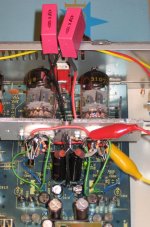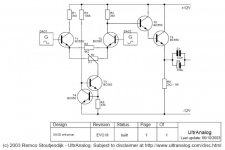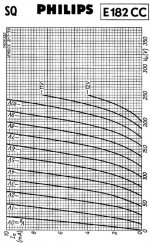Re: Re: Re: Re: Clocks and clock psu
I have a 1KVA transformer from RS somewhere in the shed !!!
6h5c said:
I've been thinking some time about getting me a 115V-CT-115V toroid and see if it makes any difference.
.
I have a 1KVA transformer from RS somewhere in the shed !!!
6h5c said:
Hi mickie,
Good to hear you are making progress. Any listening results yet???
The laserdiode is buffered by a 100n cap on the optical unit itself. You can see it in the schematics of the player (CDM12.1).
I replaced the caps on the servo PCB (C121, 122, 124, 126). C122 decouples the power to the optical unit. I changed it to 100n PPS. The unit gets it's power directly out of the TDA1302 (pin 16).
To remove the transport: here is a link that explains how to replace the laserunit. It will show you how to take the transport out.
Regards,
Ray.
Yoy can remove the traverse (laser) without stripping the whole mech down.You can even leave the draw in place but in the open position. You just need to flick out the rubber supports and desolder motor and switch etc
Thank you Ray!
Listening results are that the player still sounds kind of mediocre, can't beat Rega Planet (modded).
Upgraded PSU (BG) output (BG) opamps are still 2134; and DAC (also BG, Panasonic)
Will try to bypass HDAM; are you still convinced doing this? First impressions may change after a while
Hoping to get a "breakthrough" soon....
mickie
Listening results are that the player still sounds kind of mediocre, can't beat Rega Planet (modded).
Upgraded PSU (BG) output (BG) opamps are still 2134; and DAC (also BG, Panasonic)
Will try to bypass HDAM; are you still convinced doing this? First impressions may change after a while
Hoping to get a "breakthrough" soon....
mickie
mickie said:Thank you Ray!
Listening results are that the player still sounds kind of mediocre, can't beat Rega Planet (modded).
Upgraded PSU (BG) output (BG) opamps are still 2134; and DAC (also BG, Panasonic)
Will try to bypass HDAM; are you still convinced doing this? First impressions may change after a while
Hoping to get a "breakthrough" soon....
mickie
HDAM bypass is a breakthrough
mickie said:Thank you Ray!
Listening results are that the player still sounds kind of mediocre, can't beat Rega Planet (modded). Upgraded PSU (BG) output (BG) opamps are still 2134; and DAC (also BG, Panasonic)
Will try to bypass HDAM; are you still convinced doing this? First impressions may change after a while
mickie
You're welcome mickie. Nice BG's
They're mediocre
SimontY said:HDAM bypass is a breakthrough
I absolutely agree.
You know what beats HDAM + opamps?
This:
Attachments
I managed to place the tubes horizontally now, on a piece of scrap aluminium. The passive filter is built up on the player's PCB. At the bottom of the picture you can see two 10mH coil (the others are below the board, not enough space) and some polystyrenes. I've used wires in the opamp's holes to connect it to the tubes. They are ECC82 / 12AU7 now. Output is a bit higher compared to the original, but it's not too much. The attenuation of the filter nicely matches the amplification of the tubes.
The sound is excellent. Nice soundstage, very open mids and highs, and the s'ses and t's sound very precise, without any grain or smear. The music sound very calm, like it's flowing into the room, with great ease. The background is dead silent. The low-end sounds rich but controlled. This afternoon I listened to Pink Floyd's Dark Side of the Moon: it's analog! It's difficult to explain. I would be nice if I could attach some listening results
I have a bit of a hum when I turn the volume all the way up, but I think that's the power supply that I still use to provide the +150V.
Regards,
Ray.
The sound is excellent. Nice soundstage, very open mids and highs, and the s'ses and t's sound very precise, without any grain or smear. The music sound very calm, like it's flowing into the room, with great ease. The background is dead silent. The low-end sounds rich but controlled. This afternoon I listened to Pink Floyd's Dark Side of the Moon: it's analog! It's difficult to explain. I would be nice if I could attach some listening results
I have a bit of a hum when I turn the volume all the way up, but I think that's the power supply that I still use to provide the +150V.
Regards,
Ray.
6h5c said:
This:







Nice lightbulbs, is this mod instead of the led mod? I.E. to improve the reading of the CD's?
Regards,
Jacco
6h5c said:
You're welcome mickie. Nice BG's. But the 2134 opamps will have to go i'm afraid....
They're mediocre
I absolutely agree.
You know what beats HDAM + opamps?
This:







Nice one Ray.
If its as good has you say I may have to go tube.
Also I trust your judgement has you have tried just about every op amp combo out there
Brent
6h5c said:I managed to place the tubes horizontally now, on a piece of scrap aluminium. The passive filter is built up on the player's PCB. At the bottom of the picture you can see two 10mH coil (the others are below the board, not enough space) and some polystyrenes. I've used wires in the opamp's holes to connect it to the tubes. They are ECC82 / 12AU7 now. Output is a bit higher compared to the original, but it's not too much. The attenuation of the filter nicely matches the amplification of the tubes.
The sound is excellent. Nice soundstage, very open mids and highs, and the s'ses and t's sound very precise, without any grain or smear. The music sound very calm, like it's flowing into the room, with great ease. The background is dead silent. The low-end sounds rich but controlled. This afternoon I listened to Pink Floyd's Dark Side of the Moon: it's analog! It's difficult to explain. I would be nice if I could attach some listening results
I have a bit of a hum when I turn the volume all the way up, but I think that's the power supply that I still use to provide the +150V.
Regards,
Ray.
very nice Ray
Have you tried lower B+?
the guy's at headwise were having difficulty finding data for lower b+ voltage on valves
I'll have to try with the 6922's of 6DJ8's with 40v B+ shortly
any other suggestions on low voltage valves
allan
rowemeister said:
Nice one Ray.
If its as good has you say I may have to go tube.
Also I trust your judgement has you have tried just about every op amp combo out there
Brent
Brent
a question for Ray
Have you tried transistor or fet class A
Or is valve better to remove "digital" sound?
allan
Thanks guys. I'm very pleased with the sound. But i'm not satisfied yet 
In the next few weeks I want to see if I can tune the circuit regarding harmonic distortion. The nasty thing about low B+ and low current is that the tube is biased in the more curved area of its characteristic, and more 2nd harmonics will be present in the output signal. This sounds very "tubey", but is not what I had in mind.
I want to experiment a bit with different tubes, anode resistors and voltages. A friend of mine built a good 1kHz notch filter and a very precise 1kHz oscillator a while ago, and I hope to do some measurements with that. If I have to run the stage at +300V in the end, so what!
Allan, it is indeed hard to find tube-data at low voltages. Maybe i'm going to build a set of curves myself. It's not that difficult...
I don't think valves are the only possibility to make a nice output stage. I think it's the lack of feedback / opamps that does the trick. I expect a simple discrete FET or bipolar transistor stage will get you similar results. I want to modify the HDAM circuit into something like that, see how that sounds. It will get rid of the +150...300V
Regards,
Ray.
In the next few weeks I want to see if I can tune the circuit regarding harmonic distortion. The nasty thing about low B+ and low current is that the tube is biased in the more curved area of its characteristic, and more 2nd harmonics will be present in the output signal. This sounds very "tubey", but is not what I had in mind.
I want to experiment a bit with different tubes, anode resistors and voltages. A friend of mine built a good 1kHz notch filter and a very precise 1kHz oscillator a while ago, and I hope to do some measurements with that. If I have to run the stage at +300V in the end, so what!
Allan, it is indeed hard to find tube-data at low voltages. Maybe i'm going to build a set of curves myself. It's not that difficult...
I don't think valves are the only possibility to make a nice output stage. I think it's the lack of feedback / opamps that does the trick. I expect a simple discrete FET or bipolar transistor stage will get you similar results. I want to modify the HDAM circuit into something like that, see how that sounds. It will get rid of the +150...300V
Regards,
Ray.
Attachments
awpagan said:
Thanks.
There is another problem though. If I run the tubes too low, there will be no input-headroom for the signal. With the passive filter I built, I need at least 3V between kathode and grid. The input signal is a 5V square wave, and the filter brings it down to about 2.5V. Then I have 0.5V to spare to stay away from the 0V grid curve.
Regards,
Ray.
6h5c said:
Thanks.
There is another problem though. If I run the tubes too low, there will be no input-headroom for the signal. With the passive filter I built, I need at least 3V between kathode and grid. The input signal is a 5V square wave, and the filter brings it down to about 2.5V. Then I have 0.5V to spare to stay away from the 0V grid curve.
Regards,
Ray.
I built the V2 headphone amp with 6922's, sounded better with B+ 40V, was going to try 60V or 80V, got sidetracked
agree, if B+ too low, gets to close to the curve, very hard to bias for.
Thats why i didn't experiment with 12xa7, 12au7 etc
ps and lack of valve experience
the utralog circuit you posted before
Have a lot of bc550C/bc560C's sitting around, will have to breadboard something.
waiting on passive filter parts from RS, have arrived just need to pickup
allan
6h5c said:This one is nice, they included curves for lower current.
Why do I always pick the expensive SQ types?? What is that??
Ray.
Hi Ray,
Nice tube
Nice curves
Look at this on Ebay 5875277030
Guess who's selling it
poynton said:Hi Ray,
Nice tube
Nice curves
Look at this on Ebay 5875277030
Guess who's selling it


Hey nice tube! You have only one?
Ehm, your statement that it is a special ECC82/E82CC is wrong!

It is a totally different tube. Maybe that's why you didn't get any bids yet
ECC82: mu=17, Ri=7k7, S=2.2mA/V (@ 10.5mA)
E182CC: mu=24, Ri=1k6, S=15mA/V (@ 30mA)
Regards,
Ray.
6h5c said:
Hey nice tube! You have only one?
Ehm, your statement that it is a special ECC82/E82CC is wrong!
It is a totally different tube. Maybe that's why you didn't get any bids yet
ECC82: mu=17, Ri=7k7, S=2.2mA/V (@ 10.5mA)
E182CC: mu=24, Ri=1k6, S=15mA/V (@ 30mA)
Regards,
Ray.
Hi.
Yep - only one !
The data was taken from :-
http://www.r-type.org/inx/name.htm
Do you want to try it?
I have listed it previously with no interest.
Andy
poynton said:
Hm, I don't know where they got that idea.
Later they say: "An amplification factor of 24 is quoted. The operating conditions, performance and pin connections differ from the ECC82." Seems a bit contradictive.
Do you want to try it?
I have listed it previously with no interest.
Andy
Maybe if you had two....
Regards,
Ray.
- Home
- Source & Line
- Digital Source
- Marantz CD63 & CD67 mods list



